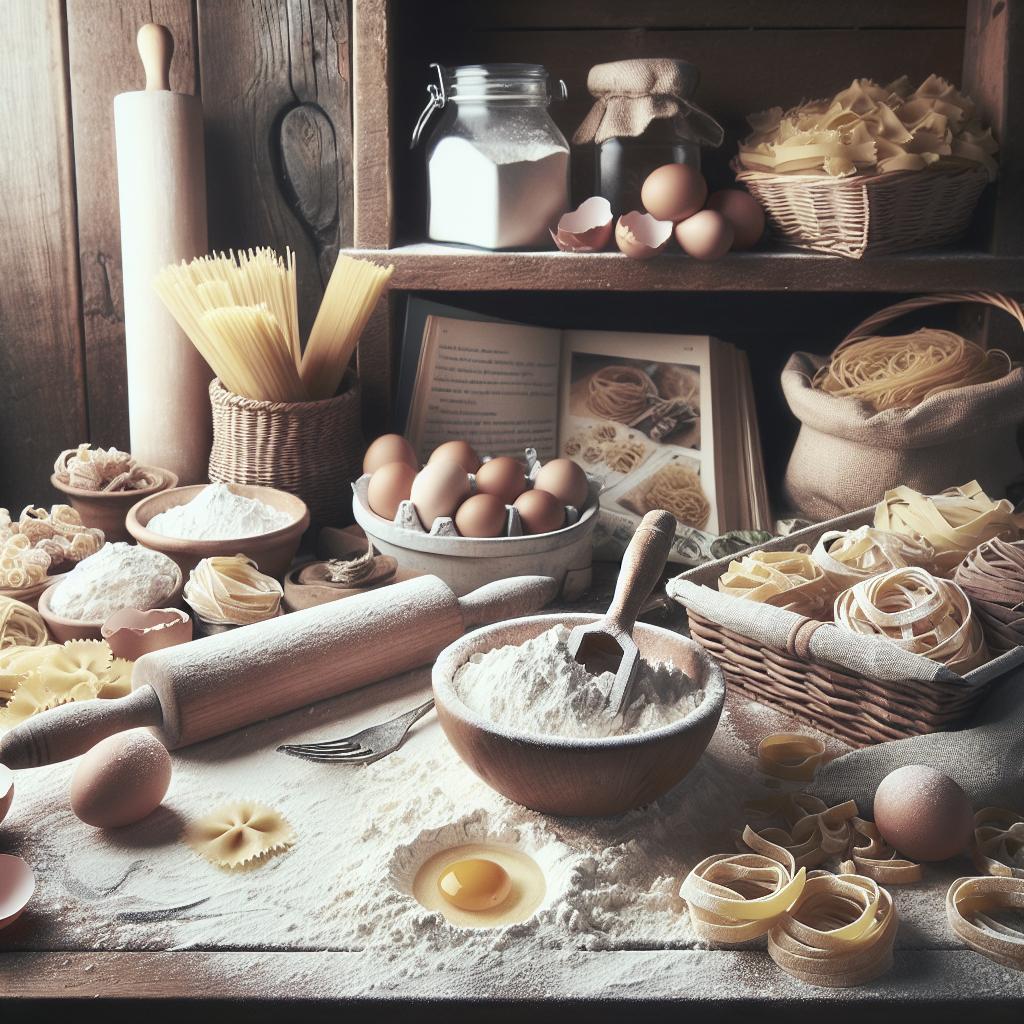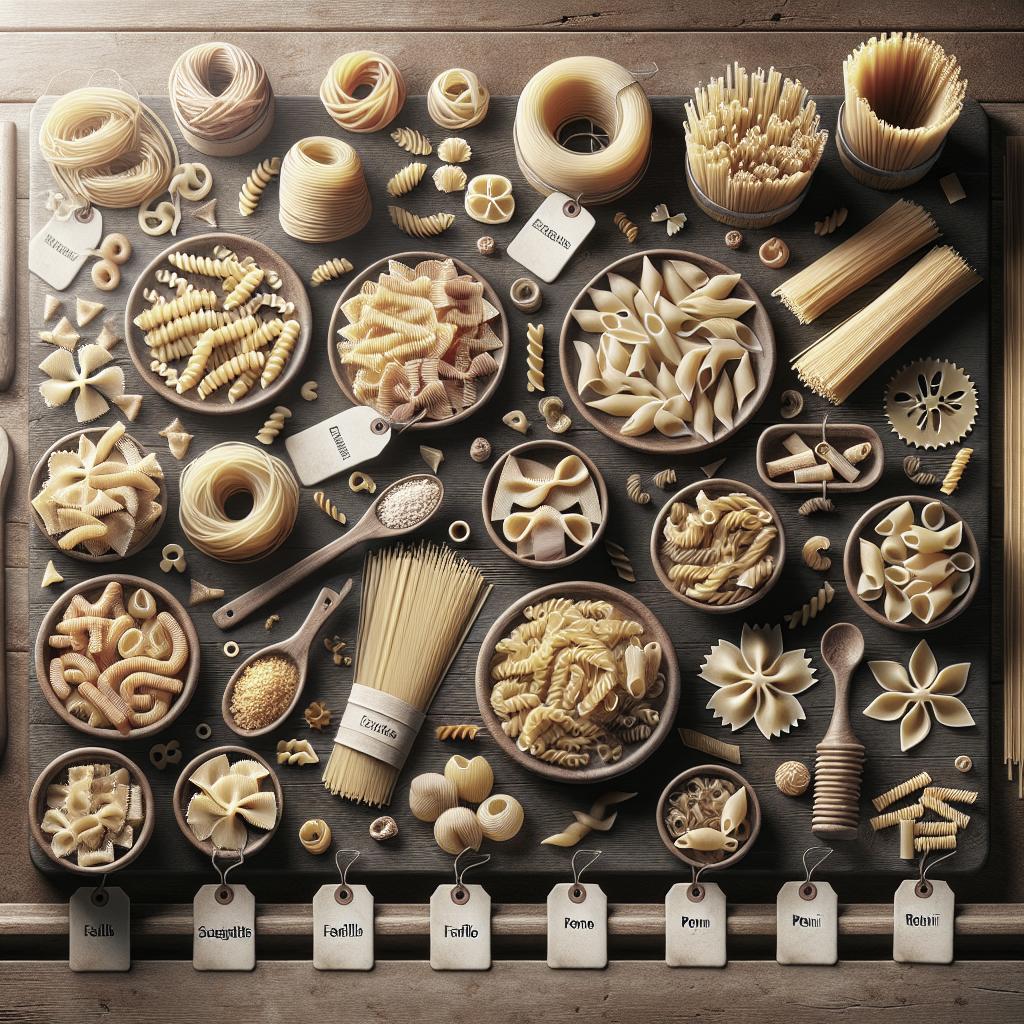“`html
Beginner’s Guide To Fresh Homemade Pasta
Embarking on the journey of making fresh pasta at home can be both exciting and rewarding. This blog post provides a comprehensive guide to mastering the art of pasta making. From understanding the basics and gathering the right ingredients to expertly rolling and cutting your dough, you’ll find detailed steps and essential tips to perfect your homemade pasta. Along with a step-by-step recipe, discover how to store, freeze, and cook fresh pasta, all while pairing it with the perfect sauce. Whether you’re a beginner or seeking to refine your skills, this guide will help transform your pasta-making experience.
Description
Fresh homemade pasta is a culinary delight that brings the authentic flavors of Italian cuisine right to your kitchen. Unlike store-bought varieties, fresh pasta is rich in taste and texture, allowing you to experiment with diverse flavors and shapes. With just a few simple ingredients, you can create a dish that is both satisfying and wholesome.
Whether you’re gearing up for a dinner party or seeking a fun weekend project, crafting fresh pasta from scratch is simpler than you might imagine. This guide will walk you through the easy-to-follow steps to achieve perfect pasta every time, ensuring a memorable dining experience for you and your loved ones.
Ingredients
To make the best fresh pasta dough, you’ll need only a handful of ingredients that are staples in any kitchen. The cornerstone of any pasta dish is, of course, flour—preferably Tipo ’00’ or all-purpose flour for its fine texture. Eggs, too, play a crucial role, contributing to the dough’s elasticity and richness. You’ll also need a pinch of salt for flavor and a splash of olive oil for added smoothness.
Having these ingredients measured and ready is key to a seamless cooking process. Precise measurements can ensure a consistency that is manageable, forgiving, and adaptable to variations, such as thickness and shape.
Instructions
Begin by creating a mound of flour on a clean surface, making a well in the center. Crack the eggs into the well, add a pinch of salt, and gradually incorporate the flour using a fork. Once the mixture takes on a dough-like consistency, knead by hand for 8-10 minutes until smooth and elastic.
After kneading, wrap the dough in plastic wrap and let it rest for at least 30 minutes. This resting period allows gluten to develop and relax, contributing to a more pliable dough. Finally, roll out the dough using a pasta machine to your desired thickness, then cut it into shapes of your choice.
Did you make this recipe?
We’d love to hear about your pasta-making experience! Share your culinary creations by leaving a comment below or tagging us on social media. Your feedback inspires us to continue sharing delicious recipes with our community of pasta enthusiasts.
Every photograph and story brings our community together, celebrating the love and passion for homemade pasta. Your journey is as unique as the pasta you create, and we are excited to be a part of it.
What Is Fresh Pasta?
Fresh pasta distinguishes itself by its tender texture and flour-forward flavor, which offers a remarkable difference compared to dried varieties. Unlike dried pasta, which is made with semolina flour and water, fresh pasta typically combines soft wheat flour and eggs. This combination creates a softer dough that cooks quickly.
Understanding the attributes of fresh pasta—such as its ability to absorb flavors—makes it an exquisite choice for dishes where simplicity and quality ingredients shine. This insight not only enhances your culinary skills but also deepens your appreciation for the nuances of Italian cuisine.
How To Make Homemade Pasta {Step-by-Step Recipe}
What To Expect.
Making homemade pasta is an enjoyable culinary project that offers hands-on satisfaction and delectable results. Expect to invest a bit of time, especially in mastering the basic techniques like kneading and rolling, but also anticipate the joy that fresh pasta brings to any meal.
Patience and practice are key. The process involves experimenting with dough hydration and finding the ideal rolling thickness. With each attempt, you’ll gain valuable skills and confidence in crafting fresh pasta tailored to your preferences.
Why This Homemade Pasta Recipe Works:
This homemade pasta recipe draws from traditional Italian methods, ensuring a perfect balance between simplicity and flavor. The combination of quality ingredients and time-tested techniques results in pasta that’s unbeatable in taste, texture, and versatility.
By following tried-and-true steps, you’ll bypass common pitfalls and achieve consistent outcomes. This recipe allows for personal tweaks, making it adaptable to varied tastes and dietary needs.
Emilie’s Homemade Pasta Tips:
Emilie recommends using fresh, local eggs for their vibrant yolks, which enrich the color and flavor of your pasta. Additionally, she emphasizes the importance of a clean work surface and maintaining a light touch when handling the dough.
The key to smooth pasta is a well-hydrated dough—neither too dry nor too sticky. Pay attention to humidity and adjust your flour quantity accordingly. Finally, don’t rush the rest period, as it’s crucial for a malleable dough.
Homemade Pasta Ingredients & Equipment (You Will Need):
Apart from the essential ingredients, having the right equipment will make the pasta-making process more efficient. A pasta machine is invaluable for rolling dough into thin sheets, but a rolling pin can work in a pinch. You’ll also need a sharp knife or pasta cutter for shaping.
For drying pasta, consider investing in a drying rack or improvise by using a clean kitchen towel. A mixing bowl, fork, and cling film for resting are also vital tools for this culinary endeavor.
Step #1: Make The Pasta Dough
Start by combining your flour and eggs as outlined, ensuring a cohesive dough. The mixing process is your opportunity to build the dough’s structure, ensuring it becomes pliable and smooth.
Kneading activates gluten, which is fundamental for achieving elasticity. Invest time here and look for a soft, almost silky texture before moving to the next step.
Step #2: Roll Dough Into Pasta Sheets
Divide the dough into smaller portions for easier handling. Flatten each portion slightly before feeding it through a pasta machine, starting on a wider setting and gradually progressing to thinner settings.
As you roll the dough, dust it intermittently with flour to prevent sticking. Smooth, even sheets signify well-prepared dough, ready for the cutting stage.
Step #3: Cut Sheets Into Pasta
Decide on your choice of pasta shape—whether it’s fettuccine, tagliatelle, or pappardelle. Utilize a sharp pasta cutter or knife and work carefully to achieve consistent shapes.
Handle each strand delicately, ensuring they are well separated to avoid sticking. At this stage, you can hang the pasta on a drying rack to dry slightly if you intend to cook it immediately.
How to Store Fresh Homemade Pasta
If not cooking right away, allow the pasta to dry slightly before storing. Place the dried pasta in an airtight container, which will keep in the fridge for up to two days.
Fresh pasta retains its texture better when eating within a couple of days, maintaining its delicate flavors and chewy texture.
How to Freeze Fresh Homemade Pasta
For longer storage, freezing fresh pasta is an excellent option. Arrange cut pasta into nests and freeze them on a baking sheet before transferring to a freezer bag.
Frozen pasta can be kept for up to three months. Cook from frozen, adding an extra minute or two to your boiling time for the best results.
How to Cook Fresh Homemade Pasta
Cooking fresh pasta requires a gentle approach. Bring a large pot of salted water to a boil, add the pasta and cook for 2-4 minutes until it floats to the top and is tender to the bite.
To ensure an al dente finish, taste the pasta frequently. Fresh pasta cooks quickly, and you should move it to your sauce immediately for the best fusion of flavors.
Best Sauce for Fresh Homemade Pasta
The beauty of fresh pasta is its versatility to pair with a range of sauces. Light, buttery sauces or simple preparations like aglio e olio allow the pasta’s flavor to shine.
For a more indulgent option, consider traditional pesto or a creamy Alfredo sauce. Balance the pasta’s delicacy with sauces that enhance rather than overpower its natural taste.
More Homemade Pasta Dough Recipes to Try!
Once comfortable with basic pasta dough, explore variations like spinach or beet-infused dough for vibrant color and flavor. Experiment with incorporating herbs or squid ink for unique taste profiles.
Broadening your repertoire of pasta shapes and flavors not only diversifies your meals but also elevates your pasta-making skills to an art form.
Watch The Video:
For visual learners, a video guide provides an insightful supplement, making each step clear and replicable. Watching the process can unravel any confusion about dough consistency or pasta machine settings.
A visual demonstration acts as your at-home mentor, inspiring and guiding you toward pasta perfection. Look for step-by-step pasta-making videos that correspond with this recipe for complete comprehension.
Final Thoughts
| Section | Content |
|---|---|
| Introduction | Overview of fresh pasta-making tips and steps. |
| Description | The joy and essence of making fresh homemade pasta. |
| Ingredients | Essential ingredients for fresh pasta dough. |
| Instructions | Step-by-step pasta dough preparation. |
| Recipe Sharing | Encouragement to share experiences and feedback. |
| Fresh Pasta | Characteristics and benefits of fresh pasta over dried. |
| Step-by-Step Recipe | Detailed guidance for making homemade pasta. |
| Storage and Cooking | Methods to store, freeze, and cook fresh pasta. |
| Pasta Sauces | Suggested sauce pairings for fresh pasta. |
| Extras and Variations | Additional recipes and creative pasta ideas. |
“`


